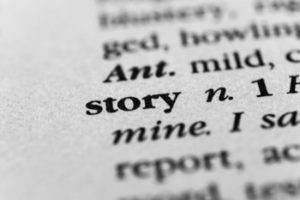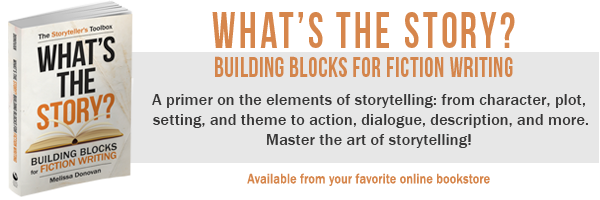
Today I’m sharing a look inside my book, What’s the Story? Building Blocks for Fiction Writing.
This excerpt is from the introduction; it talks about the magic of story and what you can expect from the book. Enjoy!
What’s the Story?
What’s a story? Is it character? Plot? Conflict? Change? Why do some stories fall flat with audiences while others sweep the globe, captivating people in every corner of the world?
Humans throughout history have used stories for a variety of purposes. Stories entertain us, taking our minds off the rigors of daily life. But stories do more than entertain. They comfort us with warmth and joy; they frighten us with horror and terror; they woo us with romance and dazzle us with adventure. They make us laugh when we’re sad or make us cry when we’re happy. Whether true or made-up, stories help us feel connected to our fellow humans. They keep us company when we’re lonely. They foster empathy by showing us what it’s like to walk in someone else’s shoes. They challenge our world views with fresh perspectives that force us to think in new ways.
We use storytelling, both as speakers and as listeners, to understand ourselves, each other, and the world we live in. And rarely do we acknowledge the power that stories hold over us. Stories can change people, cultures, even the world. We love stories. We celebrate stories. We need stories.
People will stay up all night reading a page-turner. They’ll neglect their responsibilities to marathon-watch a television series. They will stand in line—they will even sleep on the street—to see their favorite movies. Entire subcultures have been built around stories—just ask the fans who attend Comic-Con every year, fans who shell out hundreds (if not thousands) of dollars to gather with fellow story lovers and honor their favorite films, television shows, books, video games, and comics, many of them costumed as their favorite characters. That’s dedication to story, and it’s a testament to the power of storytelling.
What to Expect from the Book
Writing stories comes easily to the lucky few, but for most writers, it’s hard work that requires an elaborate set of skills. After all, stories are comprised of many moving parts: characters, plots, settings, and themes are the core elements of stories. But there’s also dialogue, action, description, and exposition, as well as a host of literary devices and storytelling techniques that we can use. Not to mention structure, point of view, tense, and voice. Understanding each of these elements and how they function together within a story empowers us to be better storytellers.
To master these building blocks of stories, we need to develop a vocabulary and aptitude for the many components that form stories.
When I first got serious about writing fiction, I searched bookstores for a basic book on storytelling. I wanted a simple primer that would help me learn and master the various components of a story, especially terms I needed to know as a storyteller. I’d hear authors talk about things like deus ex machina or the turning point at the end of act one. One expert would say, “Story is conflict.” Another would say, “Story is character.” Every time I thought I had a handle on all the elements of storytelling, I’d come across some new term that I’d never heard before, or I’d be reminded of a concept that I’d forgotten about.
I found books on character creation or plot development and even more on structure and formulas. There were plenty on writing in genre. I even found some that promised to show me how to write a story—step-by-step instructions for producing a novel. But I never did find a book that simply gathered all the elements of story in one place, a book that said, “Here are your tools and materials. Now go build something.”
After years of studying stories, writing stories, coaching fellow storytellers, and editing a range of written works, I finally decided to write that book—a primer for fiction writers who want to master the building blocks of storytelling.
What’s the Story? Building Blocks for Writing Fiction is designed to provide you with a basic but comprehensive understanding of those building blocks—the elements that work together to form a story. Using a range of stories from books, films, and television as examples, we’ll examine the components of good storytelling and explore how they fit together.
My hope is that you will come away with a broader understanding of stories, what they are made of, and how they are developed. And I hope you gain strategies that will help you tell the best story possible while exploring your own creativity and developing a storytelling process that works best for you. But most importantly, I hope this book will inspire you and motivate you to finish the stories you’ve started, begin exciting new stories, and get your stories in front of readers.
What’s the Story? Building Blocks for Writing Fiction is available at your favorite online bookstores. To find out when new books on the craft of writing are released and to get creative writing tips and ideas delivered to your email every week, subscribe to my weekly digest.
The post Sneak Peek: What’s the Story? Building Blocks for Fiction Writing first appeared on Writing Forward.
Go to Source
Author: Melissa Donovan

